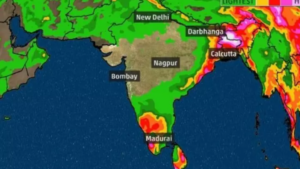
Kerala often experiences high temperatures and heat wave conditions between March and May. While North India is typically more susceptible to severe heat waves, Kerala has seen an increase in such scorching conditions over the past decade. This year, Kerala has set all-time records for both the number of severe heat wave days and the duration of heat wave conditions.
This is primarily attributed to three major natural factors, the foremost being the northward movement of the sun. During the transition from the vernal equinox (around March 23rd) to the spring season in the northern hemisphere, the Kerala region experiences the sun directly overhead from mid-March to mid-April.
Another significant factor contributing to the heatwave condition is the large body of ocean water surrounding Kerala, which increases atmospheric humidity. The primary cause of the rise in sunburn cases during this season is the presence of the sun directly overhead, which means the Sun’s rays travel a shorter distance through the atmosphere, increasing the likelihood of intense ultraviolet radiation reaching the surface. Exposure to direct sunlight during peak sun hours increases the risk of sunburn due to the high UV index.
READ I Demographic dividend: The make-or-break decade for Indian economy
El Niño and the heat wave
Another significant factor contributing to brutal hot weather is the impact of the prevailing El Niño phenomenon in the Pacific Ocean over the past nine months. The anomalous heating of the central and eastern Pacific Ocean alters global circulation patterns, resulting in the formation of an anti-cyclonic circulation characterised by a continuous high-pressure area along the southern peninsula of India and the surrounding maritime regions. This process not only increases air temperatures near the Earth’s surface but also restricts cloud formation. The Southern Peninsula has experienced prolonged and consistent hot weather conditions for the past three months, primarily due to the influence of El Niño, a natural climate variation pattern.

The Eastern and Central Arabian Seas are experiencing a temperature anomaly of around 1.5–2 degrees Celsius. The increase in ocean temperature exacerbates the severe heat wave in the Kerala region by altering local land-sea circulation patterns and increasing atmospheric humidity levels. This results in elevated nighttime temperatures around the coastal areas of Kerala.
Global warming and urbanisation
Human-induced global warming and increased urbanisation are the two main anthropogenic factors that exacerbate the incidence of more severe heatwave conditions. The urban heat island effect, where elevated temperatures are observed in densely populated and highly developed urban areas compared to their rural counterparts, is significant. Changes in land use and land cover due to human activities also influence the incidence and severity of heat waves.
Temperature records show that 2023 was the warmest year in the last 100 years and is expected to be the warmest in the last million years as well. According to data from Europe’s Copernicus Climate Change Service, the monthly anomaly has been more than 1.5°C above the preindustrial average at some point in recent months. This makes it very challenging for humans to keep global warming below 1.5 °C, the limit set by the Paris Agreement, underscoring that the climate is changing faster than previously thought.
Heatwave conditions are typically defined by two consecutive days during which the temperature surpasses a specific threshold, which varies by location. In India, heatwave conditions are officially declared when the maximum temperature exceeds 40 °C in the plains and reaches at least 30 °C in mountainous regions. However, in coastal areas such as Kerala, temperatures beyond 37 °C might be classified as a heatwave if the deviation from the average maximum temperature exceeds 4.5 °C for two consecutive days.
Humidity is a key factor in the severity of heat strokes, even though temperature governs heat exchange between the body and the environment. High humidity inhibits the body’s natural cooling mechanisms, such as sweating and transpiration, making extreme humidity particularly dangerous. Scientists have created the “Heat Index” to measure human discomfort at specific temperatures and humidity levels.
For instance, an apparent temperature of 45–50 °C can be felt when the actual temperature is 37 °C with 65% humidity. This is the main cause of discomfort along Kerala’s coast. Heat stress and rapid temperature rises impair the body’s ability to regulate temperature, leading to conditions like heat cramps, heat exhaustion, sunburn, heat stroke, hyperthermia, and worsening chronic conditions such as cardiovascular and respiratory complications, kidney disease, and more. Heatstroke can be fatal in extreme cases.
Extreme heat also indirectly affects human behavior, the transmission of diseases, health service delivery, air quality, energy, transport, water quality, agricultural production, animal husbandry, and low-income households. Vulnerable groups include infants, children under four, seniors, patients with chronic illnesses, construction workers, and athletes, especially when exercising in intense heat.
Recent research indicates that the incidence of heatwaves has been rising in low-income countries over the past four decades, with these countries experiencing a 40% higher exposure to heat waves from 2010 to 2019 than high-income countries. Those regions with lower incomes have less capacity to adapt to warming, which makes the effects of increasing heatwave exposure even more severe. It is projected that by the end of the century, the poorest countries will experience heatwaves two to five times more frequently than the richest countries.
Health risk due to heat waves
The health risks posed by climate change are likely to affect many outdoor workers disproportionately. Those in sectors such as agriculture, construction, transportation, landscaping, oil production, firefighting, and emergency response are among the first to feel the effects of climate change. There is an increased risk of industrial injuries associated with heat exposure. In heat-exposed occupations, decreased labor capacity and productivity due to excessive heat can lead to an increase in accidents, particularly where cognitive capacities (such as attention) and reaction times (e.g., drivers) are compromised.
Elevated ambient temperatures increase the likelihood of fires resulting from fermentation or self-heating of materials or products, overheating of electrical equipment, or high heat pressure. This phenomenon is pervasive in many sectors of business but is particularly prevalent in waste storage sites and waste treatment plants.
India has seen a significant increase in the occurrence of heat waves and the number of deaths caused by heat. Since the 1990s, over 17,000 fatalities have been attributed to heat waves. During the summer of 2010, Gujarat experienced a maximum temperature that surpassed 47 °C, resulting in nearly 1,300 fatalities. In response, the National Disaster Management Authority implemented heat action plans, which include comprehensive early warning systems and preparedness procedures. The objectives of these programs are to increase public awareness and engagement, enhance coordination across different agencies, improve the skills of healthcare professionals, reduce heat exposure, and encourage the use of adaptive solutions.
Starting in 2016, the India Meteorological Department (IMD) began issuing heat wave alerts at different lead times, such as weekly and monthly predictions. This initiative has enabled local stakeholders to create tailored action plans for their cities, evidenced by a decline in heat-related death rates since 2016. Local and state governments are currently implementing resilience strategies to tackle heatwaves. Resilience strategies for extreme heat should include the development of heat preparedness plans, identification of the most vulnerable populations, implementation of cool, green roofs and pavements to mitigate heat island effects, and the planting of trees to provide shade and facilitate evapotranspiration, thereby cooling the surrounding environment.
India experiences the severest weather in May and June, so the worst of extreme heat wave conditions have not yet developed across the country. It is imperative that all stakeholders, including communities, local self-governing bodies, and individuals, are adequately equipped to manage the situation. In light of the parliamentary elections occurring this year, the Election Commission has already issued explicit guidelines governing the conduct of elections and election campaigns. It is time to contemplate rescheduling the election to a season with cooler temperatures, as this could potentially account for the reduced voter turnout. Unfortunately, climate change and heat-related crises are not addressed in any of the political manifestos.
(Dr Abhilash S is the director of Advanced Center for Atmospheric Radar Research, Cochin University of Science and Technology.)
